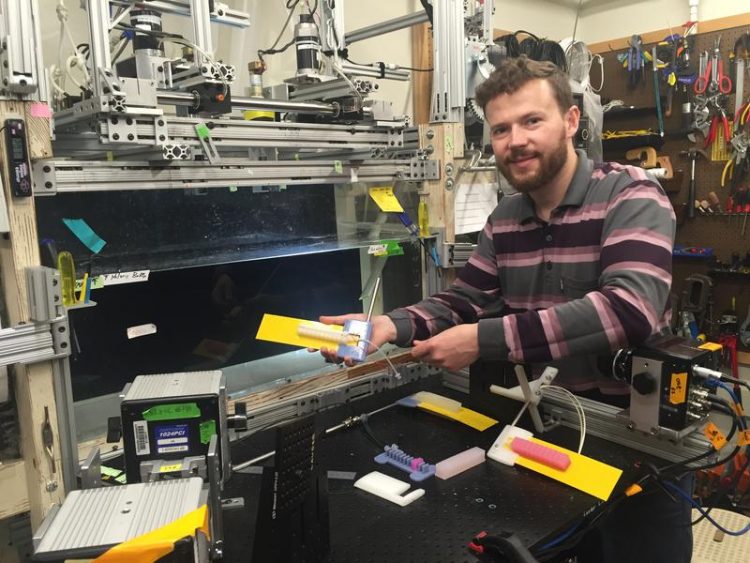Swimming robot gives valuable insights into locomotion of fish

Ardian Jusufi and the soft robophysical model fish Image: Cyber Valley
Scientists at the Max Planck Institute for Intelligent Systems who are part of the Cyber Valley research consortium together with researchers from Harvard University developed a swimming soft robot and studied its wave-like forward propulsion under water.
The soft robophysical model serves as a ‘model animal’ aiming to decipher the complex locomotion behaviors observed in the natural world. The scientists extract the design principles and locomotion capabilities to build better robots, but most importantly to gain valuable knowledge about the morphological intelligence of animals.
Their paper “Fish-like aquatic propulsion studied using a pneumatically-actuated soft-robotic model” was published in the journal Bioinspiration & Biomimetics on June 9, 2020.
When a fish swims in water, electrical impulses travel in waves through its muscles. From head to tail, the animal bends back and forth, creating a forward thrust during locomotion. The researchers investigated how different parameters affect the swimming movement.
They wanted to find out what influence it has to swimming whether a fish body is stiff or floppy, by measuring how fast the body swings from right to left to propel the system. In real living fishes, such parameters are difficult to isolate and measure individually – hence the team built a fish robot.
The team developed a pneumatically actuated, fish-like model made of soft silicone and used it to investigate the thrust forces triggered by different parameters and how they influence each other. They measured the forward thrust as well as the side forces and torques generated during swimming using a statistical linear model.
“We found that both stiffness and frequency substantially affect swimming kinematics, and that there are complex interactive effects of these two parameters on thrust,” says Ardian Jusufi, who is head of the Cyber Valley independent research group “Locomotion in Biorobotic & Somatic Systems” at the MPI-IS.
“The stiffer the backbone of our fish-like robot, the more important is an increasing frequency to generate thrust.” For stiffer biorobotic models, increasing frequency resulted in higher values for both thrust and lateral forces, he adds. However, large lateral forces in turn reduced the swimming efficiency. Jusufi and colleagues were able to mitigate this effect by smaller wave movements and by appropriately phasing the left and right body movements, reduced the amplitudes of the lateral force.
“This research cooperation aims at understanding the musculoskeletal system of animals, which is our priority,” Jusufi says. “As we observe the unique maneuvers and strategies utilized by animals, our goal is also to decipher their morphological intelligence with robophysical modelling.
Robotics-inspired biology can help us to better understand the spectacular and graceful movement observed in natural systems, drawing conclusions as to why evolution produced a certain solution.” It is a learning cycle where biology helps design better robot locomotion and the robot opens up insights into biology that would not be possible otherwise.
In the end, researchers like Jusufi gain a deeper understanding of both. In this spirit, Jusufi’s lab has also advocated for the greater utilization of soft robotics (incl. soft sensors [1]) to uncover neuromechanical insights in a forthcoming publication in Wiley Advanced Intelligent Systems [2].
Relevant sources:
[1] Wearable and Stretchable Strain Sensors: Materials, Sensing Mechanisms, and Applications. Souri, Banerjee, Jusufi, Radacsi, Stokes, Park, Sitti, Amjadi. Advanced Intelligent Systems. 2020 (2). DOI: 10.1002/aisy.202000039.
[2] Soft Sensors for Curvature Estimation under Water in a Soft Robotic Fish. Wright, Vogt, Wood, and Jusufi. IEEE International Conference on Soft Robotics 2019. https://ieeexplore.ieee.org/document/8722806
About:
Cyber Valley is Europe’s largest research consortium in the field of artificial intelligence with partners from science and industry. The state of Baden-Württemberg, the Max Planck Society with the Max Planck Institute for Intelligent Systems, the Universities of Stuttgart and Tübingen, as well as Amazon, BMW AG, Daimler AG, IAV GmbH, Dr. Ing. h.c. F. Porsche AG, Robert Bosch GmbH, and ZF Friedrichshafen AG are the founding partners of this initiative. Moreover, Fraunhofer Gesellschaft has joined Cyber Valley as an associated partner. Cyber Valley also receives support from the Christian Bürkert Foundation, the Gips-Schüle Foundation, the Vector Foundation, and the Carl Zeiss Foundation.
Media Contact:
Lennart Schmid
Cyber Valley Communications
c/o Tübingen AI Research Building
Maria-von-Linden-Str. 6, 72076 Tübingen, Germany
Mobile: +49 160 91289359
Email: lennart.schmid@cyber-valley.de
Zane Wolf
Organismic and Evolutionary Biology
Harvard University, Cambridge, USA
Email: zwolf.mlxvi@gmail.com
Dr. Ardian Jusufi
Locomotion in Biorobotic & Somatic Systems
Max Planck Institute for Intelligent Systems, Stuttgart, Germany
Email: ardian@is.mpg.de
Daniel Vogt
Harvard Microrobotics Lab and Wyss Institute
Harvard University, Cambridge, USA
Email: daniel.vogt@wyss.harvard.edu
Prof. George Lauder
Museum of Comparative Zoology
Harvard University, Cambridge, USA
Email: glauder@oeb.harvard.edu
Media Contact
All latest news from the category: Life Sciences and Chemistry
Articles and reports from the Life Sciences and chemistry area deal with applied and basic research into modern biology, chemistry and human medicine.
Valuable information can be found on a range of life sciences fields including bacteriology, biochemistry, bionics, bioinformatics, biophysics, biotechnology, genetics, geobotany, human biology, marine biology, microbiology, molecular biology, cellular biology, zoology, bioinorganic chemistry, microchemistry and environmental chemistry.
Newest articles

High-energy-density aqueous battery based on halogen multi-electron transfer
Traditional non-aqueous lithium-ion batteries have a high energy density, but their safety is compromised due to the flammable organic electrolytes they utilize. Aqueous batteries use water as the solvent for…

First-ever combined heart pump and pig kidney transplant
…gives new hope to patient with terminal illness. Surgeons at NYU Langone Health performed the first-ever combined mechanical heart pump and gene-edited pig kidney transplant surgery in a 54-year-old woman…

Biophysics: Testing how well biomarkers work
LMU researchers have developed a method to determine how reliably target proteins can be labeled using super-resolution fluorescence microscopy. Modern microscopy techniques make it possible to examine the inner workings…





















